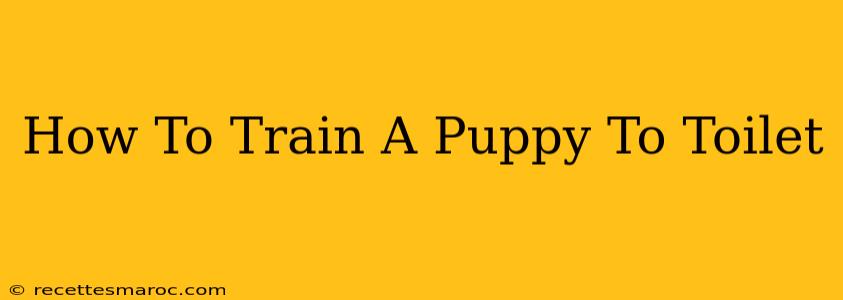House training a puppy can be challenging, but with patience and consistency, you can successfully teach your furry friend where to relieve themselves. This comprehensive guide provides a step-by-step approach to puppy toilet training, covering crucial techniques and addressing common problems. Let's get started!
Understanding Your Puppy's Needs
Before diving into training methods, it's vital to understand your puppy's biological needs. Puppies have small bladders and bowels, requiring frequent potty breaks. The general rule is:
- Number of months old + 1 = Number of hours they can hold it. For example, a 3-month-old puppy can generally hold it for approximately 4 hours.
- Always take them out after waking up, eating, drinking, and playing. These activities stimulate bowel and bladder functions.
Ignoring these biological cues increases the likelihood of accidents, setting back your training progress.
Establishing a Consistent Routine
Consistency is key to successful toilet training. A predictable routine helps your puppy learn to associate specific times with going outside. Here's what you should do:
- Create a potty schedule: Based on your puppy's age, establish a regular schedule of potty breaks. Stick to this schedule as closely as possible.
- Choose a designated potty spot: Select a specific area in your yard for your puppy to eliminate. This helps them associate that spot with toileting.
- Use a consistent command: Choose a short, simple word or phrase, such as "Go potty," "Outside," or "Do your business." Say this command each time you take your puppy to their designated spot.
Positive Reinforcement Techniques
Positive reinforcement is far more effective than punishment. Reward your puppy immediately after they eliminate outside with praise, treats, or a favorite toy. This positive association will motivate them to repeat the desired behavior.
- Immediate rewards: The faster you reward your puppy, the better they'll understand the connection between going potty outside and receiving a reward.
- High-value treats: Use small, tasty treats your puppy loves to reinforce the positive behavior.
- Praise and affection: Combine treats with enthusiastic praise and petting to strengthen the positive association.
Dealing with Accidents
Accidents will happen, even with the best training. The key is to react calmly and clean up the mess effectively:
- Avoid punishment: Scolding or rubbing your puppy's nose in the accident will only create fear and anxiety, hindering the training process.
- Thorough cleaning: Use an enzymatic cleaner to remove the odor completely. Residual smells can attract your puppy back to the same spot.
- Supervise closely: After an accident, increase supervision to prevent future ones. Restrict your puppy's access to areas where accidents have occurred.
Crate Training and its Benefits
Crate training can be a valuable tool in toilet training. Dogs instinctively avoid soiling their den. A crate provides a safe and secure space:
- Proper crate size: Ensure the crate is large enough for your puppy to stand, turn around, and lie down comfortably, but not so large that they can eliminate in one corner and sleep in another.
- Gradual introduction: Introduce your puppy to the crate gradually, making it a positive experience with treats and toys.
- Never use the crate as punishment: The crate should be a safe haven, not a place of confinement.
Troubleshooting Common Problems
- Puppy refusing to go outside: Try changing locations, using different treats, or even waiting a little while before trying again.
- Frequent accidents: This may indicate a medical issue or an improperly sized crate. Consult your vet to rule out medical problems and adjust training methods if needed.
- Chewing and destructive behavior: Make sure your puppy has plenty of appropriate chew toys and redirect them from undesirable chewing behaviors.
Patience and Consistency are Key
Remember, toilet training takes time and patience. Every puppy learns at a different pace. Consistency in your approach, positive reinforcement, and a watchful eye will significantly increase your chances of success. Celebrate the small victories and don't get discouraged by setbacks. With dedication and the right techniques, you'll soon have a house-trained puppy!

